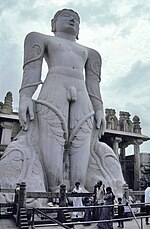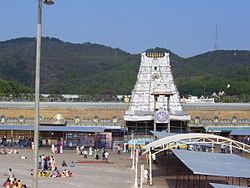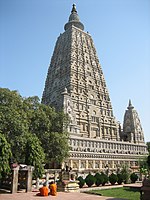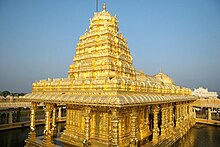Indian religions
Indian religions or Dharmic religions is a classification for religions that originated in the Indian subcontinent; namely Hinduism, Jainism, Buddhism and Sikhism.[1] These religions are also classified as Eastern religions. Although Indian religions are connected through the history of India, they constitute a wide range of religious communities and Indian religions are not confined to the Indian subcontinent.[1]
The documented history of Indian religions begins with historical Vedic religion, the religious practices of the early Indo-Aryans, which were collected and later redacted into the Samhitas (usually known as the Vedas), four canonical collections of hymns or mantras composed in archaic Sanskrit. These texts are the central shruti (revealed) texts of Hinduism. The period of the composition, redaction and commentary of these texts is known as the Vedic period, which lasted from roughly 2000 to 1500 BCE.
The late Vedic period (9th to 6th centuries BCE) marks the beginning of the Upanisadic or Vedanticperiod.[2][3] This period heralded the beginning of much of what became classical Hinduism, with the composition of the Upanishads, later the Sanskrit epics, still later followed by the Puranas.
Indian philosophy is a confluence of Śramaṇic (self-reliant) and Vedic streams that co-exist and influence each other.[4] Jainism and Buddhism belong to the sramana tradition. Jainism was established by a lineage of 24 enlightened beings culminating with Parsva (9th century BCE) andMahavira (6th century BCE).[5] Buddhism was historically founded by Siddhartha Gautama, a Kshatriyaprince-turned-ascetic, and was spread beyond India through missionaries. It later experienced a declinein India, but survived in Nepal and Sri Lanka, and remains more widespread in Southeast and East Asia.
Certain scholarship holds that the practices, emblems and architecture now commonly associated with the Hindu pantheon and Jainism may go back as far as Late Harappan times to the period 2000–1500 BCE.[6][7]
Hinduism is divided into numerous denominations, primarily Shaivism, Shaktism, Vaishnavism, Smartaand much smaller groups like the conservative Shrauta. Hindu reform movements are more recent. About 90% of Hindus reside in the Republic of India, accounting for 83% of its population.[8]
Sikhism was founded in the 15th century on the teachings of Guru Nanak and the nine successive Sikh Gurus in Northern India.[9] The vast majority of its adherents originate in the Punjab region.
 Common traits
Common traits
Sometimes summarised as Dharmic religions or dharmic traditions (though subtleties in the meaning of Dharma or dhamma differs according to the religion), Hinduism, Buddhism, Jainism and Sikhism share certain key concepts, which are interpreted differently by different groups and individuals.[10][11][12]
Common traits can also be observed in both the ritual and the literary sphere. For example, the head-anointing ritual of abhiseka is of importance in three of these distinct traditions, excluding Sikhism (in Buddhism it is found withinVajrayana). Other noteworthy rituals are the cremation of the dead, the wearing of vermilion on the head by married women, and various marital rituals. In literature, many classical narratives and purana have Hindu, Buddhist or Jain versions.[13] All four traditions have notions of karma,dharma, samsara, moksha and various forms of Yoga. Of course, these terms may be perceived differently by different religions. For instance, for a Hindu, dharma is his duty. For a Jain, dharma is righteousness, his conduct. For a Buddhist, dharma is usually taken to be the Buddha's teachings. Similarly, for a Hindu, yoga is the cessation of all thoughts/activities of the mind.[14] For Jains, Yoga is the sum of all physical, verbal and mental activities.
Rama is a heroic figure in all of these religions. In Hinduism he is the God-incarnate in the form of a princely king; in Buddhism, he is a Bodhisattva-incarnate; in Jainism, he is the perfect human being. Among the Buddhist Ramayanas are: Vessantarajataka,[15] Reamker,Ramakien, Phra Lak Phra Lam, Hikayat Seri Rama etc. There also exists the Khamti Ramayana among the Khamti tribe of Asom wherein Rama is an Avatar of a Bodhisattva who incarnates to punish the demon king Ravana (B.Datta 1993). The Tai Ramayana is another book retelling the divine story in Asom.
Prehistory
Evidence attesting to prehistoric religion in the Indian subcontinent derives from scattered Mesolithic rock paintings such as at Bhimbetka, depicting dances and rituals. Neolithic agriculturalists inhabiting the Indus RiverValley buried their dead in a manner suggestive of spiritual practices that incorporated notions of an afterlife and belief in magic.[16] Other South Asian Stone Age sites, such as the Bhimbetka rock shelters in central Madhya Pradesh and the Kupgal petroglyphs of eastern Karnataka, contain rock art portraying religious rites and evidence of possible ritualised music.[17] The Harappan people of the Indus Valley Civilization, which lasted from 3300–1300 BCE (mature period, 2600-1900 BCE) and was centered around the Indus and Ghaggar-Hakra river valleys, may have worshiped an important mother goddess symbolising fertility,[18] a concept that has recently been challenged.[19] Excavations of Indus Valley Civilization sites show small tablets with animals and altars, indicating rituals associated with animal sacrifice.
Vedic tradition
Vedic period
Main article: Historical Vedic religion
The Vedic Period is most significant for the composition of the four Vedas, Brahmanas and the older Upanishads (both presented as discussions on the rituals, mantras and concepts found in the four Vedas), which today are some of the most important canonical textsof Hinduism, and are the codification of much of what developed into the core beliefs of Hinduism.
The Vedas reflect the liturgy and ritual of Late Bronze Age to Early Iron Age Indo-Aryan speaking peoples in India. Religious practices were dominated by the Vedic priesthood administering domestic rituals/rites and solemn sacrifices. The Brahmanas, Aranyakas and some of the older Upanishads (such as BAU, ChU, JUB) are also placed in this period. Many elements of Vedic religion reach back to early Bronze Age Proto-Indo-Iranian times. The Vedic period is held to have ended around 500 BCE.
Specific rituals and sacrifices of the Vedic religion include:
- The Soma cult described in the Rigveda, descended from a common Indo-Iranianpractice.
- Fire rituals, also a common Indo-Iranian practice (See Zoroastrianism):
- The Agnihotra or oblation to Agni.
- The Agnistoma or Soma sacrifice (including animal sacrifice) .
- The Agnicayana, the sophisticated ritual of piling the Uttara fire altar.
- The Darsapaurnamasa, the fortnightly New and Full Moon sacrifice
- The Caturmasya or seasonal sacrifices (every four months)
- a large number of sacrifices for special wishes (Kāmyeṣṭi)
- The Ashvamedha or horse sacrifice.
- The Purushamedha, or sacrifice of a man, imitating that of the cosmic Purusha and Ashvamedha
- The rites referred to in the Atharvaveda are concerned with medicine and healing practices, as well as some charms and sorcery (white and black magic).
- The domestic (grihya) rituals deal with the rites of passage from conception to death and beyond.
Vedanta
Main article: Vedanta
The period of Vedanta (Sanskrit : end of Vedas), typically thought to have begun around 600 BCE, marked the end of the evolution of the main Vedic texts; it also accompanied the transformation of the semi-nomadic nature of the Indo-Aryan tribes to agriculture-based polities, as they increasingly formed permanent settlements in the Indo-Gangetic plain and other parts of Northern India. This period was foreshadowed by the Brahmanas that interpreted the four canonical Vedas in various fashions, which finally led to the Upanishads. While the ritualistic status of the four Vedas remained undiminished, the early Upanishads mainly relate to spiritual insights. At this time, the concepts of reincarnation, samsara, karma, and moksha began to be accepted in ancient India within the sphere of the priestly establishment i.e. the Brahmana class. Some scholars think that these new concepts developed by aborigines outside the caste system,[20] others detect Sramana or even Ksatriya influence. These concepts were eventually accepted by Brahmin orthodoxy, and were to form much of the core philosophies of the later epics and Hinduism, as well as, against a different philosophical and religious background, in Buddhism and Jainism.
Astika and Nastika categorization
See also: Adi Shankara and Charvaka
Astika and nastika are sometimes used to categorise Indian religions. Those religions that believe that God is the central actor in this world are termed as astika. Those religions that do not believe that God is the prime mover and actor are classified as nastika religions. From this point of view the Vedic religion (and Hinduism) is an astika religion, whereas Buddhism and Jainism are nastika religions.
Another definition of the terms astika and nastika, followed by Adi Shankara, classifies religions and persons as astika and nastikaaccording to whether they accept the authority of the main Hindu texts, the Vedas, as supreme revealed scriptures, or not. By this definition, Nyaya, Vaisheshika, Samkhya, Yoga, Purva Mimamsa and Vedanta are classified as astika schools, while Charvaka is classified as a nastika school. By this definition, both Buddhism and Jainism are classified as nastika religions since they do not accept the authority of the Vedas.
Shramana (self-reliant) tradition
Main article: Shramana
See also: Gautama Buddha and Mahavira
The Vedic religion of Iron Age India co-existed and closely interacted with the parallel non-Vedic shramanatraditions.[4][21][22][23] These were not direct outgrowths of Vedism, but separate movements that influenced it and were influenced by it.[24] The shramanas were wandering ascetics. Buddhism and Jainism are a continuation of the Shramana tradition, and the early Upanishadic movement was influenced by it.[25][26][27][28][29][30] The 24th Tirthankara of Jainism, Mahavira (599–527 BCE), stressed five vows, including ahimsa (non-violence), satya (truthfulness), asteya(non-stealing) and aparigraha (non-attachment). A previous Tirthankara, Parshva, is also accepted as a historical figure from early in the shramana tradition.
Gautama Buddha, who was called an "awakened one" (Buddha), was born into the Shakya clan living at Kapilavastu and Lumbini in what is now southern Nepal. The Buddha was born at Lumbini, as emperor Asoka's Lumbini pillar records, just before the kingdom of Magadha (which traditionally is said to have lasted from 546–324 BCE) rose to power. The Shakyas claimed Angirasa and Gautama Maharishi lineage,[31] via descent from the royal lineage of Ayodhya.
Rise and spread of Jainism and Buddhism
Main articles: Pre-sectarian Buddhism, History of Buddhism in India, Silk Road transmission of Buddhism, and Jain community
See also: History of Buddhism and Timeline of Jainism
Further information: Maurya Empire and Gupta Empire
Both Jainism and Buddhism spread throughout India during the period of the Magadha empire. Scholars Jeffrey Brodd and Gregory Sobolewski write that "Jainism shares many of the basic doctrines of Hinduism and Buddhism."[32] and scholar James Bird writes, "But when primitive Buddhism originated from Hindu schools of philosophy, it differed as widely from that of later times, as did the Brahmanism of the Vedas from that of the Puranas and Tantras."[33]
Buddhism in India spread during the reign of Ashoka of the Maurya Empire, who patronised Buddhist teachings and unified the Indian subcontinent in the 3rd century BCE. He sent missionaries abroad, allowing Buddhism to spread across Asia.[34] Jainism began its golden period during the reign of Emperor Kharavela of Kalinga in the 2nd century BCE.
Both Jainism and Indian Buddhism declined following the rise of Puranic Hinduism during the Gupta dynasty. Buddhism continued to have a significant presence in some regions of India until the 12th century.
Jainism continues to be an influential religion and Jain communities live in Indian states Gujarat, Rajasthan, Madhya Pradesh, Maharashtra,Karnataka and Tamil Nadu. Jains authored several classical books in different Indian languages for a considerable period of time.
Period after 200 BCE
Further information: Puranas
After 200 CE several schools of thought were formally codified in Indian philosophy, including Samkhya, Yoga, Nyaya, Vaisheshika,Mimāṃsā and Advaita Vedanta.[35] Hinduism, otherwise a highly polytheistic, pantheistic or monotheistic religion, also toleratedatheistic schools. The thoroughly materialistic and anti-religious philosophical Cārvāka school that originated around the 6th century BCE is the most explicitly atheistic school of Indian philosophy. Cārvāka is classified as a nāstika ("heterodox") system; it is not included among the six schools of Hinduism generally regarded as orthodox. It is noteworthy as evidence of a materialistic movement within Hinduism.[36] Our understanding of Cārvāka philosophy is fragmentary, based largely on criticism of the ideas by other schools, and it is no longer a living tradition.[37] Other Indian philosophies generally regarded as atheistic include Samkhya and Mimāṃsā.
Between 400 CE and 1000 CE Hinduism expanded as the decline of Buddhism in India continued.[38] Buddhism subsequently became effectively extinct in India but survived in Nepal and Sri Lanka.
There were several Buddhistic kings who worshiped Vishnu, such as the Gupta Empire, Pala Empire, Malla Empire, Somavanshi, andSattvahana.[39] Buddhism survived followed by Hindus. National Geographic[40] edition reads, "The flow between faiths was such that for hundreds of years, almost all Buddhist temples, including the ones at Ajanta, were built under the rule and patronage of Hindu kings."
Post-Vedic development of Hinduism
Main article: History of Hinduism
The end of the Vedantic period around the 2nd century AD spawned a number of branches that furthered Vedantic philosophy, and which ended up being seminaries in their own right. The output generated by these specialized tributaries was automatically considered a part of the Hindu or even Indian philosophy. Prominent amongst these developers were Yoga, Dvaita, Advaita and the medieval Bhakti movement. The modern day popular movements were the ones founded by Swami Vivekananda, Sri Aurobindo, Raja Ram Mohan Roy among others.
In the latter Vedantic period, several texts were also composed as summaries/attachments to the Upanishads. These texts collectively called as Puranas allowed for a divine and mythical interpretation of the world, not unlike the ancient Hellenic or Roman religions. Legends and epics with a multitude of gods and goddesses with human-like characteristics were composed. Two of Hinduism's most revered epics, theMahabharata and Ramayana were compositions of this period. Devotion to particular deities was reflected from the composition of texts composed to their worship. For example theGanapati Purana was written for devotion to Ganapati (or Ganesh). Popular deities of this era were Shiva, Vishnu, Durga, Surya, Skanda, and Ganesh (including the forms/incarnations of these deities.)
Bhakti Movement
The Bhakti Movement began with the emphasis on the worship of God, regardless of one's status - whether priestly or laypeople, men or women, higher social status or lower social status.
The movements were mainly centered around the forms of Vishnu (Rama and Krishna) and Shiva. There were however popular devotees of this era of Durga.
The most well-known devotees are the Alwars from southern India. The most popular Vaishnava teacher of the south was Ramanuja, while of the north it was Ramananda.
Several important icons were women. For example, within the Mahanubhava sect, the women outnumbered the men,[41] and administration was many times composed mainly of women.[42] Mirabai is the most popular female saint in India.
Sri Vallabha Acharya (1479–1531) is a very important figure from this era. He founded the Shuddha Advaita (Pure Non-dualism) school of Vedanta thought.
Shaivism
The most well-known devotees are the Nayanars from southern India. The most popular Shaiva teacher of the south was Basava, while of the north it was Gorakhnath.
Recent groups
The modern era has given rise to dozens of Hindu saints with international influence. For example, Brahma Baba established the Brahma Kumaris, one of the largest new Hindu religious movements which teaches the discipline of Raja Yoga to millions. Representing traditional Gaudiya Vaishnavism, Prabhupada founded the Hare Krishna movement, another organization with a global reach. In late 18th century India, Swaminarayan founded theSwaminarayan Sampraday. Anandamurti, founder of the Ananda Marga, has also influenced many worldwide. Through the international influence of all of these new Hindu denominations, many Hindu practices such as yoga, meditation, mantra, divination, and vegetarianism have been adopted by new converts.
Sikhism
Main article: Sikhism
Sikhism originated in fifteenth century Northern India with the teachings of Nanak and nine successive gurus. The principal belief in Sikhism is faith in Vāhigurū— represented by the sacred symbol of ēk ōaṅkār [meaning one god]. Sikhism's traditions and teachings are distinctly associated with the history, society and culture of the Punjab. Adherents of Sikhism are known as Sikhs (students or disciples) and number over 23 million across the world.
Ravidassia Religion
Main article: Ravidassia Religion
The Ravidassia religion is a monotheistic religion based on the teachings of the 14th century Indian guru Ravidass, revered as a satguru and prophet by his followers. Ravidass, a Chamar Dalit ("untouchable") by birth, taught monotheistic spirituality and a message of equality and emancipation from the Indian caste system.
Status in the Republic of India
In a judicial reminder, the Indian Supreme Court observed Sikhism and Jainism to be sub-sects or special faiths within the larger Hindu fold,[43] and that Jainism is a denomination within the Hindu fold.[44] Although the government of British India counted Jains in India as a major religious community right from the first Census conducted in 1873, after independence in 1947 Sikhs and Jains were not treated as national minorities.[45] In 2005 the Supreme Court of India declined to issue a writ of Mandamus granting Jains the status of a religious minority throughout India. The Court however left it to the respective states to decide on the minority status of Jain religion.[46][47]
However, some individual states have over the past few decades differed on whether Jains, Buddhists and Sikhs are religious minorities or not, by either pronouncing judgments or passing legislation. One example is the judgment passed by the Supreme Court in 2006, in a case pertaining to the state of Uttar Pradesh, which declared Jainism to be indisputably distinct from Hinduism, but mentioned that, "The question as to whether the Jains are part of the Hindu religion is open to debate.[48] However, the Supreme Court also noted various court cases that have held Jainism to be a distinct religion.
Another example is the Gujarat Freedom of Religion Bill, that is an amendment to a legislation that sought to define Jains and Buddhists as denominations within Hinduism.[49] Ultimately on July 31, 2007, finding it not in conformity with the concept of freedom of religion as embodied in Article 25 (1) of the Constitution, Governor Naval Kishore Sharma returned back the Gujarat Freedom of Religion (Amendment) Bill, 2006 citing the widespread protests by the Jains[50] as well as Supreme Court's extrajudicial observation that Jainism is a "special religion formed on the basis of quintessence of Hindu religion by the Supreme Court.
















No comments:
Post a Comment
Jayant Parkash Is Welcome All world to my blog